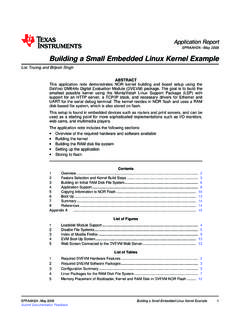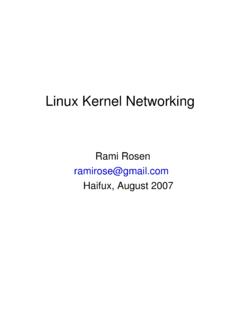Transcription of Embedded Linux - Opersys
1 Embedded Linux2 Delivered and/or Customized by:These slides are made available to you under a Creative Commons Share-Alike license. The full terms of this license are here: requirements and misc., PLEASE READ: This slide must remain as-is in this specific location (slide #2), everything else you are free to change; including the logo :-) Use of figures in other documents must feature the below Originals at URL immediately under that figure and the below copyright notice where appropriate. You are free to fill in the Delivered and/or customized by space on the right as you see fit. You are FORBIDEN from using the default About the instructor slide as-is or any of its contents.(C) Copyright 2003-2012, Opersys slides created by: Karim YaghmourOriginals at: Structure and the by day About the instructor Author of: Introduced Linux Trace Toolkit in 1999 Originated Adeos and relayfs ( )52.
2 Goals To provide an in depth understanding of an Embedded Linux system's architecture. To enable you to put together an Embedded Linux system with as little 3rd party dependencies as possible in an architecture independent fashion. To give you a hands on experience of putting together and programming Embedded Linux systems. To teach you how open source and free software packages are developed and how to take advantage of that development Presentation Format Course has two main tracks: Lecture: Instructor presents and discusses material Exercises: Attendees put to practice the material presented with instructor assistance. Fast pace. Answers to some questions will be postponed until relevant section is covered. Given that there is a lot of material, the instructor will set the speed as Expected Knowledge Basic Embedded systems experience Basic understanding of operating system concepts.
3 C programming experience Basic grasp of open source and free software philosophy. Good understanding of the debugging process Good understanding of complex project architecture85. Knowledge fields Main fields: Embedded systems Linux kernel internals Device driver development Unix system administration GNU software development Traditionally, no single person possesses complete knowledge in all these fields. As your experience increase, you will need to look more closely at the relevant Day by day outline Day 1: booting a custom kernel and filesystem10 Day 2: flash, images, internals and storage and installing the hardware support10. Device driver overview (start)11 Day 3: debugging, real time and driver overview (continued) debugging time Linux services12 Day 4: toolchain building and human interfaces tools , the human factor Appendix:A Linux basics137.
4 Courseware Embedded Linux slides manual. Exercise set Building Embedded Linux Systems, 2nd ed. 14 Motorola EVB5200 / Lite5200 / Ice Cube : PowerPC based target CPU: MPC5200 (MPC603e core) Freq: 400 MHz RAM: 64MB Flash: 16MB I/O: Serial, Ethernet, CAN, I2S, USB, .. Manufacturer: Motorola Model: Lite5200 CAREFUL: Use ESD wrist strap8. Hardware15 TQ Components TQM860: PowerPC based target CPU: MPC860 Freq: 80 MHz RAM: 16MB Flash: 8MB I/O: Serial, Ethernet, CAN, .. Manufacturer: TQ Components Model: TQM860 CAREFUL: Use ESD wrist 's 's Embedded 's real time architecture of an Embedded Linux startup171. What's Linux kernel / system / distribution Broad definition / many interpretations GNU/ Linux anyone? Strict definition: Linux is the kernel developed and maintained by Linus Torvalds.
5 Linux kernel : Provides core system facilities Manages system through its lifecycle (next reboot) Controls all hardware Provides higher level abstractions to software18 Old kernel version identification scheme: Three digits: => version number z => release number Linux is release 21 of version Linux is release 73 of version Even version number (ex.: ) => stable tree Odd version number (ex.: ) => development tree Real life kernel version identification schemes: rmk4 hh24 ( ) / 8 (Rhat)19 Current version identification scheme Four digits: => version number z => release number a => stablization increment These four digit releases are not maintained by Linus, but rather by other kernel developers Goal: Provide stable/fixes only releases.
6 Starting from Release cycle: After major stable release, 2 week window for major features. released, merge window opened for (x+1) Merge window close = (x+1) rc1 6 to 10 week bug fixing brings new (x+1) rcN When stable, (x+1) release Lather, rinse, repeat No , or 2.(6+n) planned for now Maybe when PREEMPT_RT goes fully in = What's Embedded Linux Embedded Linux doesn't exist There is no specific kernel for Embedded systems There are, nevertheless, customized kernels specially configured / customized for specific Embedded hardware configurations. What does exist: Embedded Linux system Embedded Linux development distribution Embedded Linux target distribution22 Embedded Linux system: An Embedded system running the Linux kernel User space tools & configuration likely to be very different from desktop (uClibc instead of glibc, BusyBox instead of core utils, etc.)
7 Embedded Linux development distribution: Includes all the tools and packages required for developing software for Embedded Linux systems. Embedded Linux target distribution: Includes binaries and related packages to be used directly in Embedded Linux What's real time Linux Originally (prior to 1999), there was one main real time Linux extension: RTLinux (first written by M. Barabanov under V. Yodaiken's supervision.) Today, the main players are: PREEMPT_RT Xenomai Legacy: RTLinux RTAI244. Generic architecture of an Embedded Linux system Little or no difference between architecture of a standard Linux system and that of an Embedded Linux kernel 's hardware requirements: 32 bit CPU Memory Management Unit (MMU) Minimal amount of RAM ROM/flash/storage to load/mount root filesystem kernel 's responsibilities: Drive devices Manage I/O access Manage memory Manage storage devices Control process scheduling Provide Unix API to applications Low level interfaces: Very hardware specific Provide hardware independent API Typically handles: CPU specific operations, architecture specific memory ops, basic device interfaces.
8 High level abstractions: Provide Unix abstractions (processes, files, sockets, and signals.) Code implementing these abstractions is identical across all architectures (with some minor exceptions.)27 Filesystems: Organize storage devices into recognizable formats Linux supports over 40 different filesystems Virtual Filesystem layer provides transparent and uniform API to all filesystems. Linux requires at least one properly structured root filesystem Networking protocols Organize the traffic on the wires Linux supports more than a dozen different protocols Socket API provides uniform API to all networking28 Libraries: Applications almost never access the Linux kernel 's services directly. Libraries provide more abstract services than those provided by the kernel .
9 The main library used with the kernel : glibc Substitutes for glibc include: uClibc and eglibc Dynamic linking allows only one copy of each library to be present at all times. Static linking is preferable if a limited set of applications are using a limited set of a library's System startup Software taking part in the system's startup: Bootloader kernel Init process Bootloader: First to run Initializes hardware to a known state Places kernel parameters for the kernel to find Loads kernel and jumps to it30 kernel : Early startup code is very hardware dependent Initializes environment for the running of C code Jumps to the architecture independent start_kernel() function. Initializes high level kernel subsystems Mounts root filesystem Starts the init process The init process takes care of loading all the user applications and starting the various a practical project Development control321.
10 Using a practical project workspace Need to organize the components used during cross platform development. Workspace layout:bootldr:target bootloader (s)build tools:toolchain build packages and sourcesdebug:debugging toolsdoc:project documentationimages:binary images ready to be used on targetkernel:sources and build directories for target kernelsproject:your own custom code for the targetrootfs:root filesystem as seen on the targetsysapps:sources for target's system applicationstmp:temporary data and experimentstools:toolchain and all other tools required to buildsoftware for the Location can vary, but $HOME is highly recommended. Script for facilitating access to workspace:export PROJECT=example-sysexport PRJROOT=/home/karim/${PROJECT}cd $PRJROOT To use this script:$.





